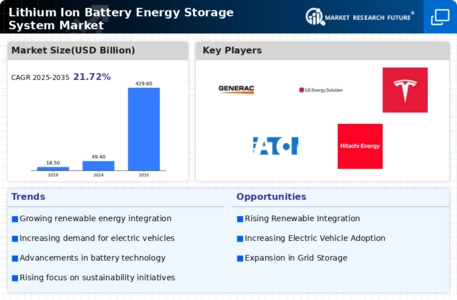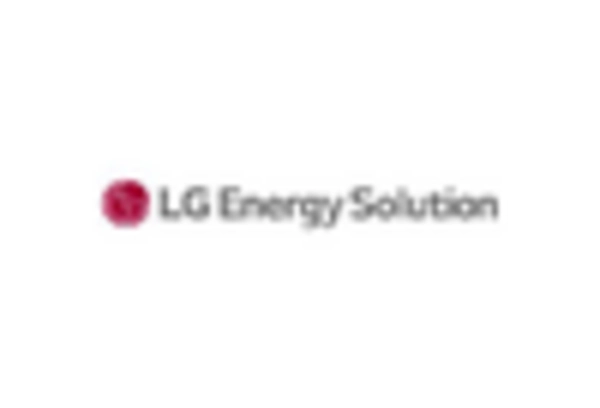Rising Environmental Concerns
The Lithium Ion Battery Energy Storage System Market is increasingly influenced by rising environmental concerns and the push for sustainable energy solutions. As climate change becomes a pressing issue, there is a growing emphasis on reducing carbon emissions and transitioning to cleaner energy sources. Lithium-ion batteries play a crucial role in this transition by enabling the storage of renewable energy, thus facilitating its use when needed. The market is projected to grow as more organizations and governments prioritize sustainability initiatives. This shift towards environmentally friendly energy storage solutions is likely to enhance the adoption of lithium-ion batteries in various sectors.
Increasing Energy Storage Needs
The Lithium Ion Battery Energy Storage System Market is experiencing a surge in demand due to the increasing need for energy storage solutions. As energy consumption rises, particularly in urban areas, the necessity for efficient energy storage systems becomes paramount. This trend is further amplified by the growing integration of renewable energy sources, which often produce energy intermittently. According to recent data, the energy storage capacity is projected to reach 1,000 GWh by 2030, indicating a robust growth trajectory. This increasing energy storage need is likely to drive investments in lithium-ion battery technologies, enhancing their market presence and adoption.
Growing Electric Vehicle Adoption
The Lithium Ion Battery Energy Storage System Market is closely linked to the rising adoption of electric vehicles (EVs). As the automotive sector increasingly shifts towards electrification, the demand for lithium-ion batteries is expected to soar. In 2025, it is estimated that the number of electric vehicles on the road will surpass 30 million, creating a substantial market for lithium-ion batteries. This growth in the EV sector not only drives demand for batteries but also encourages advancements in battery technology, which can be leveraged in energy storage systems. Consequently, the synergy between EV adoption and energy storage solutions is likely to enhance the market landscape.
Increased Focus on Grid Stability
The Lithium Ion Battery Energy Storage System Market is witnessing heightened attention towards grid stability and reliability. As energy grids become more complex with the integration of renewable energy sources, the need for reliable energy storage solutions becomes critical. Lithium-ion batteries offer rapid response times and high efficiency, making them suitable for stabilizing the grid during peak demand periods. Recent studies indicate that energy storage systems can reduce grid operation costs by up to 30 percent. This focus on grid stability is likely to propel investments in lithium-ion battery technologies, further solidifying their role in energy storage applications.
Declining Costs of Lithium-Ion Batteries
The Lithium Ion Battery Energy Storage System Market is benefiting from the declining costs associated with lithium-ion battery production. Over the past decade, the cost of lithium-ion batteries has decreased significantly, with prices dropping by approximately 89 percent since 2010. This reduction in costs is attributed to advancements in manufacturing processes and economies of scale. As prices continue to fall, the adoption of lithium-ion batteries for energy storage applications is expected to rise, making them more accessible for both residential and commercial users. This trend is likely to bolster the market, as more stakeholders recognize the economic viability of lithium-ion energy storage solutions.

















Leave a Comment